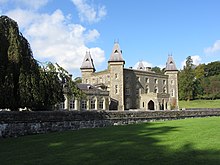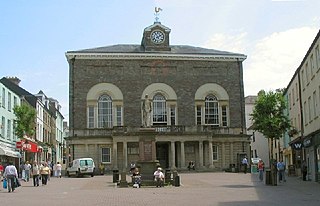
Carmarthenshire is a county in the south-west of Wales. The three largest towns are Llanelli, Carmarthen and Ammanford. Carmarthen is the county town and administrative centre. The county is known as the "Garden of Wales" and is also home to the National Botanic Garden of Wales.

Llandeilo is a town and community in Carmarthenshire, Wales, situated at the crossing of the River Towy by the A483 on a 19th-century stone bridge. Its population was 1,795 at the 2011 Census. It is adjacent to the westernmost point of the Brecon Beacons National Park. The town is served by Llandeilo railway station on the Heart of Wales Line.
Cwmamman is a community in Carmarthenshire, about 12 miles north of Swansea in southwest Wales. Literally meaning "Amman valley", it takes its name from the River Amman which runs through the area.

Dinefwr was one of six local government districts of the county of Dyfed, Wales from 1974 to 1996. It was named after Dinefwr Castle which in the Middle Ages had been the court of the House of Dinefwr and one of the three principal royal courts of Wales with Aberffraw and Shrewsbury.

Walter FitzUryan Rice, 7th Baron Dynevor was a British military officer, civil servant and Conservative politician. He was the only son and heir of the 6th Baron Dynevor.
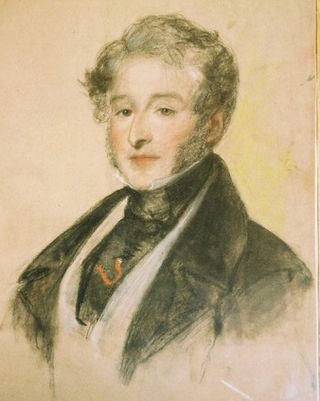
George Talbot Rice, 3rd Baron Dynevor (Dinefwr) was a British peer and politician. He was the son of Cecil de Cardonnel, 2nd Baroness Dynevor and George Rice. He was educated at Westminster School and matriculated at Christ Church, Oxford on 1 February 1783, where he was awarded a Master of Arts degree on 30 May 1786.

Richard Charles Uryan Rhys, 9th Baron Dynevor was a British peer.
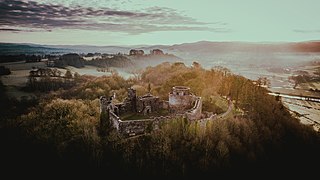
Dinefwr Castle is a ruined castle overlooking the River Towy near the town of Llandeilo, Carmarthenshire, Wales. It lies on a ridge on the northern bank of the Towy, with a steep drop of one hundred feet to the river. Dinefwr was the chief seat of the Dinefwr dynasty of the Kingdom of Deheubarth. The castle is a Grade I listed building.
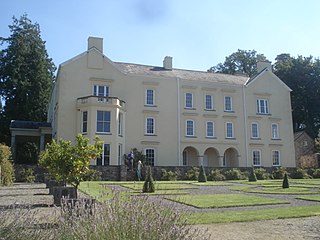
Aberglasney House and Gardens is a medieval house and gardens set in the Tywi valley in the parish of Llangathen, Carmarthenshire, West Wales. It is owned and run by Aberglasney Restoration Trust, a registered charity. The house is a Grade II* listed building and the gardens are listed, also at Grade II*, on the Cadw/ICOMOS Register of Parks and Gardens of Special Historic Interest in Wales.

The Royal House of Dinefwr was a cadet branch of the Royal House of Gwynedd, founded by King Cadell ap Rhodri, son of Rhodri the Great. Their ancestor, Cunedda Wledig, born in late Roman Britain, was a Sub-Roman warlord who founded the Kingdom of Gwynedd during the 5th century, following the Anglo-Saxon settlement of Britain. As Celtic Britons, the House of Dinefwr was ruling before the Norman conquest, having to fight with their neighbors such as the Celtics, Anglo-Saxons and Vikings, before struggling with the Normans afterwards. Many members of this family were influential in Welsh history, such as Hywel Dda, who codified Welsh law under his rule, and achieved the important title of King of the Britons, or Lord Rhys, Prince of Wales, who rebelled against Richard the Lionheart, and became one of the most powerful Welsh leaders of the Middle Ages.
Ffairfach is a village one-half mile (0.80 km) south of the market town of Llandeilo in the eastern part of Carmarthenshire, Wales. It is close to the confluence of the Afon Cennen and the River Towy. Population is 516 according to 2017 census.
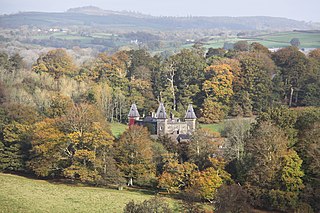
Dinefwr Park National Nature Reserve is an 800 acres (320 ha) estate about a mile from the centre of Llandeilo in Carmarthenshire owned by the National Trust, with a mansion in the centre. The highest point is occupied by the ruined Dinefwr Castle, ancient castle of the Deheubarth kingdom. It is a grade I Historic Park and a Site of Special Scientific Interest.

Castle House in Laugharne, Carmarthenshire, Wales, is a Grade II*–listed Georgian mansion. Described by Dylan Thomas as “the best of houses in the best of places”, it is one of many buildings of note in the medieval township.

George Rice was a Welsh politician and courtier. He became Vice-Admiral of Carmarthen, Lord Lieutenant of Carmarthenshire, and Lord Commissioner of the board of trade under the Duke of Newcastle.
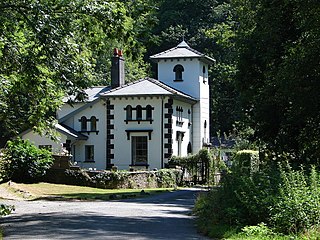
Richard Kyrke Penson or R. K. Penson was a Welsh architect and artist.

Iscoed, Ferryside, Carmarthenshire, Wales is a ruined eighteenth century mansion attributed to the architect Anthony Keck. Constructed for Sir William Mansel in 1772, it was purchased by the Napoleonic general Sir Thomas Picton as an incomplete shell in 1812. The house remained the property of the Picton family until the end of the First World War. Used subsequently as council housing, it has been empty since the 1950s, and is now a derelict shell. The house is Grade II listed.

Alban Square, in the centre of Aberaeron, Ceredigion, Wales is a range of early 19th century townhouses. The town of Aberaeron was developed around 1810 as a port by the Rev. Alban Thomas Jones Gwynne, a local landowner. After his father's death in 1819, Colonel A.T.J. Gwynne engaged Edward Haycock Sr. to plan a major expansion. Leases were sold in the early 1830s and Alban Square was designed, but largely unbuilt, by 1834. The town grew as a centre for shipbuilding and commerce. The expansion of the railways, and their arrival in Aberaeron in 1909 brought these commercial endeavours to an end and the town became a seaside resort and a centre for local government. No.s 9-20 inclusive on Alban Square are Grade II* listed buildings, their Cadw listing records describing the square as "a well preserved terrace in a key location".

Portland Place, in the centre of Aberaeron, Ceredigion, Wales is a terrace of mid-19th century townhouses. The town of Aberaeron was developed around 1810 as a port by the Rev. Alban Thomas Jones Gwynne, a local landowner. After his father's death in 1819, Colonel A.T.J. Gwynne engaged Edward Haycock Sr. to plan a major expansion. Leases were sold in the early 1830s and development continued for much of the rest of the 19th century, the town growing as a centre for shipbuilding and commerce. The expansion of the railways, and their arrival in Aberaeron in 1909 brought these commercial endeavours to an end and the town became a seaside resort and a centre for local government. No.s 1-7 inclusive on Portland Place are Grade II* listed buildings, forming "the finest single terrace" in Aberaeron.

Carmarthenshire is a county in the south-west of Wales. It covers an area of 2,370 km2 (920 sq mi). In 2021 the population was approximately 188,200.






